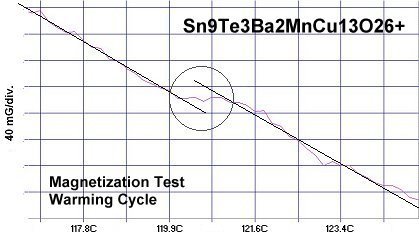
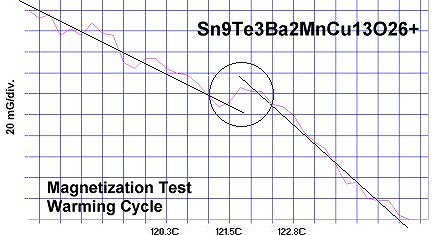


February 2015 marks the tenth anniversary of the discovery of the first superconductor created through the application of planar weight disparity (PWD). Exploiting this fundamental component of high temperature superconductivity has led to the discovery of more than 80 new superconductors with transition temperatures now approaching 100 degrees above room temperature.
The most recent discovery is a tin-tellurium copper-oxide with the chemical formula Sn9Te3Ba2MnCu13O26+. It is the 22nd material found to exhibit superconductivity above room temperature, establishing a new world record of 119 Celsius (392K, 246F). 1
Confirmation of superconductivity was made through 18 magnetization tests that produced sharp diamagnetic (Meissner) transitions with an average temperature of 119.3 Celsius. Two of these tests are shown at page top. The straight lines approximate the average of the data points, skewing apart at Tc, the critical transition temperature.
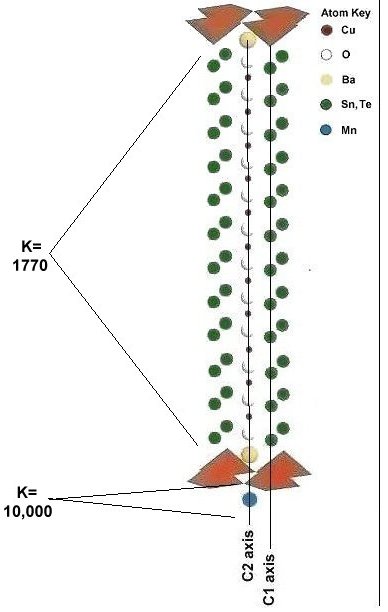
|
Like the 110C superconductor announced in November 2014, this copper-oxide ceramic exploits a high dielectric constant (K) in both the MnO2 anion and SnTe cation layers to complement a high planar weight ratio (PWR) along the C axis. Its N212 target structure (shown at left) is identical to that of its 110C progenitor. In order to achieve its higher Tc, three tellurium atoms are substituted into three of the six antimony atomic sites; with three additional tin atoms going into the remaining antimony sites. SnTe has a dielectric constant (K) of 1770, which is an order of magnitude higher than the 147 Kappa of SnSb. However, tellurium has an oxidation state of +4. So the tin/tellurium ratio had to be adjusted from 6:6 to 9:3 to avoid over-doping the insulating layers with electrons.2 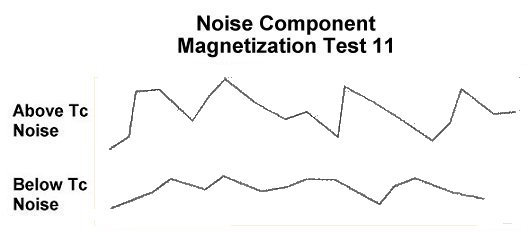 Confirmation of superconductivity also comes from a drop in thermal noise below Tc. As show in the above graphic, there is a sudden and quantifiable drop in RMS noise below 119 Celsius in the magnetization plots. This phenomenon has been observed previously in every room-temperature superconductor formulation. Click HERE to read more on this.3 |
The dots within the below grid show how Tc has advanced in the copper-oxides through correspondingly higher planar weight ratios. Those compounds in the yellow box not only have the highest planar weight ratios, they feature a high dielectric constant (K) as well. At the same PWR, the high Kappa compounds have significantly higher transition temperatures.
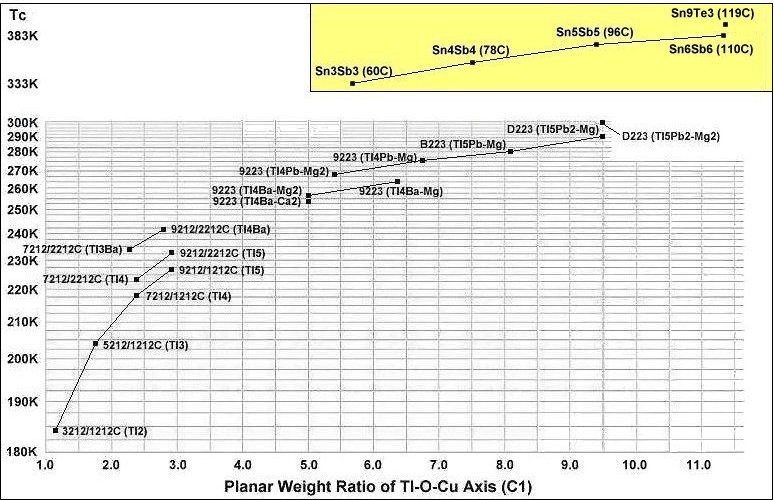
In order to maximize formation of the N212 structure, Sn9Te3Ba2MnCu13O26+ was synthesized using the layer cake method, as shown below. The pellet had approximately 100 interference layers. And, even using this layering technique, the volume fraction is low, requiring very sensitive test equipment.
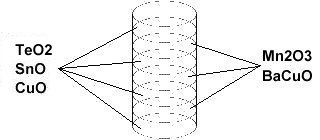
Stoichiometric ratios of the below chemicals were used for the ODD layers:
SnO 99.9% (Alfa Aesar) 8.77 grains...and the below ratios for the EVEN layers.
BaCuO 99.9% (Alfa Aesar) 3.14 grainsThe chemical precursors were pelletized at 60,000 PSI and pre-sintered for 24 hours at 715C. The pellet was then sintered for 10 hours at 880C and annealed for 10+ hours at 500C in flowing O2. Temperature was determined using an Omega type "T" thermocouple and precision OP77 DC amplifier. The magnetometer employed twin Honeywell SS94A1F Hall-effect sensors with a tandem sensitivity of 50 mv/Gauss.
RESEARCH NOTE: The copper-oxides are strongly hygroscopic. All tests should be performed immediately after annealing.
RE-PUBLICATION NOTICE: Elsevier Publishing, dba Elsevier Science, as well as Morris Communications, both print and broadcast divisions, are specifically prohibited from re-publishing any part of this news story.
E. Joe Eck
© 2015 Superconductors.ORG
All rights reserved.
1. Testing temperatures are believed accurate within ± 0.5 degrees C.
2. Dielectric constants were obtained from H. P. R. Frederikse, CRC Handbook of Chemistry and Physics.
3. Resistance tests were not possible with this material due to the non-superconductive bulk having a resistance
greater than 40 megohms. A measurable
bulk resistance is necessary to observe a resistance change at Tc.
 BACK to "News" page at Superconductors.ORG
BACK to "News" page at Superconductors.ORG